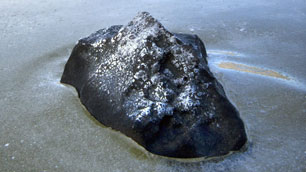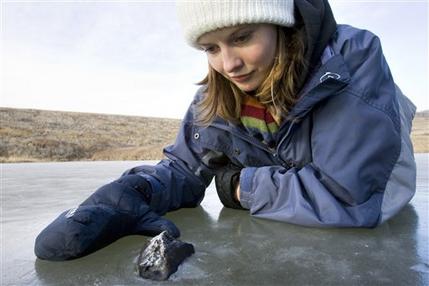[/caption]
On Nov. 27, planetary scientist Dr. Alan Hildebrand from the University of Calgary and graduate student Ellen Milley brought reporters to a site where they have found numerous meteorite fragments from the bolide that streaked across the sky in Western Canada on Nov. 20. The area where the meteroite fragments were found is called Buzzard Coulee, about 40 kilometers from the town of Lloydminster, on the Alberta-Saskatchewan border. There, around a frozen pond, numerous small rocks and pebbles could be seen that the scientists said were from the meteorite. No large chunks were spotted, however, reporters said.

The fireball that streaked across western Canadian skies was witnessed by thousands, and Hildebrand believes it was a 10-ton fragment from an asteroid. Videos from surveillance and police cameras showed the meteor exploding before it hit the ground. Reporters were told those observations, combined with the physical evidence, give scientists a treasure trove of data that could give them a better understanding of the solar system. The reports don’t offer any indications of the type of meteorite the fragments are, but from the images they appear to possibly be iron. We’ll add more images and information as they become available.


These are probably ordinary chondrites, early analysis seems to show.
So they pieces were actually stuck in a frozen pond? 😀 That’s awesomely easy to identifiy then.
[…] El 27 de noviembre, el Dr. Alan Hildebrand, de la Universidad de Calgary, y la estudiante del tercer ciclo Ellen Milley, llevaron a un grupo de periodistas al lugar donde habían encontrado numerosos fragmentos del bólido que estremeció el cielo occidental de Canadá el pasado 20 de noviembre. […] Fuentes: Nancy Atkinson para Universe Today, y otros.
Thats probably how they knew it was chips from the main rock, being that those bits had to land there after the last freezing.
Thay sad taht its site of grape…anyway beutiful girl 🙂
Nice finding and truely nice girl. But as I’m no rocket-scientist so could anyone, please, explain: the meteorite hits the atmosphere at a speed of app. 14 km per second. It fragmented into smaller pieces, burning in that fantastic video. So what is approximately the speed of that piece of rock hitting the ice ? Thanks for explonation.
Is it just me, or does it freak anyone else out that large pieces like this are hitting the ground?
What if it had been slightly bigger?
What if it caused a crater? Or worse…
When i first saw the security camera footage, it seriously almost looks as if the whole place was blown up, until you see the last couple frames where it dampens in brightness.
Probably not that fast.
After it hit the thick air and exploded into smaller pieces, it would have dropped from mach whatever back down to sub sonic speeds.
So figure out how fast a similarly sized rock falls when dropped from 1000 feet or so, and you’d have hit.
Thank you, Maxwell !
You’d think that ice would be cracked a bit around the impact site, at least several meteor diameters away from the meteor. I guess it’s possible that the entire pond melted a bit during warm weather or from sunshine after the meteor struck before refreezing. That would explain the relatively fresh looking ice around the impact site. Alternately the meteor came in at a steep angle and bounced to its present location after hitting land or some other spot on the ice. Some melting appears to have ocurred within one diameter of the rock as evidenced by the swirly pattern in the ice around the meteor. Some photos taken with a polarizing filter might better show the effects of the meteor on the original ice.
It depends on the mass and velocity of the object and the density altitude at impact. Terminal velocity of smaller objects at density altitudes of ~4,000 feet or less is ~120 mph. Larger objects will likely retain higher velocities due to their greater mass. For example, the recent meteor strike in Peru near Lake Titicaca in Sept. 2007 left an impact crater approximately 30m. across and 19m. deep, at an elevation above 12,500ft. .
Aren’t those little pieces worth a small fortune?
@ bse5150
I should certainly hope so.
I wonder if someone else found it, they could sell it on.
Don’t be surprised if pieces of this rock will surface on internet, summing up to tens of tons!
Fascinating stuff. The fragment might’ve hit somewhere else on the pond or the surrounding ground, then slid or skipped around – being still warm from entry, melted the ice and sank to its present position.
Wow, just wow. Some of the things that go on beyond our planet are comprehensible, until tomorrow.
It could have hit right there, too.
There may have been enough heat in the rock to melt the ice it impacted, then it would have refroze in place. Making it hard to see any spiderwebbing cracks.
No doubt there will be ebay scams and profiteers trying to sell anything they find… but hopefully they can preserve all the debris sites before it gets out of hand.
Hunnter asks
“Is it just me, or does it freak anyone else out that large pieces like this are hitting the ground?”
It used to spook me, too…. until a chunk about the size of the piece in the picture (but more nicely rounded) hit the roof of a neighbour’s house. I would have expected it to leave a ruin behind – three or four broken tiles was the total extend of the damage.
Another one was seen streaking all the way across the Eastern US of A and ended up hitting a car in NYC. It smashed the left front wing and headlight – nobody was injured.
I’ve heard of (and have seen) a lot more damage done by rocks thrown by people at things (or other people) than rocks falling out of the sky. They are also usually a lot more targeted…….. and there are plenty of people who do this sort of thing.
Now, that’s REALLY scary!
# Joel Says:
“…Larger objects will likely retain higher velocities due to their greater mass…”
True, but probably more relevant is the ratio of mass to meteor’s surface area. This assumes that the braking affect of the air is proportional to surface area (which is probably an over simplification!).
More specifically it will depend on the initial kinetic energy when it hits the Earth’s atmosphere and the force of deceleration caused by atmospheric drag. Also we both implicitly assumed that the meteor would not simply burn up…
Anyhow, I would expect that if 2 meteors of the same mass and kinetic energy hit at the same angle… then the denser one would hit the ground at a faster speed.
Hmm… when one starts to think about it, there are a huge number of factors to consider, in order to decide even one impact parameter!
-Gavin
Can I have it please?
Is that it !!!! SHEEEESH. Please, print something when you actually know you have it. That could of been planted.
Well, what made the Barringer crater in Arizona? I thought that iron meteorites stuck together and made holes while the rocky ones broke apart.
Sometimes, this kind of news on TV can be funny. KNBC-TV has a good weather bookie (Dallas Raines).
Once, some years ago, a sizeable meteorite was tracked into the nearby Rose Valley. On TV, Mr Raines suggested that people head for the Rose Valley to look for pieces.
Unfortunately, the Rose Valley contains millions of volcanic bombs from the cinder cone there. An expert might be able to spot a meteorite fragment but to the average person these things look alike.
Wow so small, I expected something much bigger!
“Wow so small, I expected something much bigger!”
That’s what she said that’s what she said that’s what she said!
That feels much better…
First!!!1!1!!
What meteorite? I don’t see the meteorite. All I see is Ms. Milley.
how far do you think it travelled before reaching us?
Imagine what this rock has seen!
This rock won’t of seen too much….it has no eyes.
That looks a lot like the tip of an iceberg. Hopefully many more pieces will show up.
Yeah, maybe someone threw a handful of pieces on the pond to get all the trespassers off the scent of the real location…
Hey, Ms. Milley, Bet you could use some more tuition money. Just one small one would do. Say 15 grammer or so? Dr. Hillenbrand wouldn’t even know it was gone!
homer simpson was right: “it’ll burn up in our atmosphere and whatever’s left will be no bigger than a chihuahua’s head”
An estimate of asteroidal material between orbit of Mercury and Jupiter suggests that approximately 20x10exp21 ton of metal and rock exist in the inner solar system in the form of asteroids and unbound particles. This is about four times the mass of the Earth. The true quantity must be twice this figure. It is obvious that there is more to the inner solar system than what appears. One thing is for certain: genesis of the Earth is a continuing process. It would be wise to leave
meteorites alone on the ground where they have fallen.